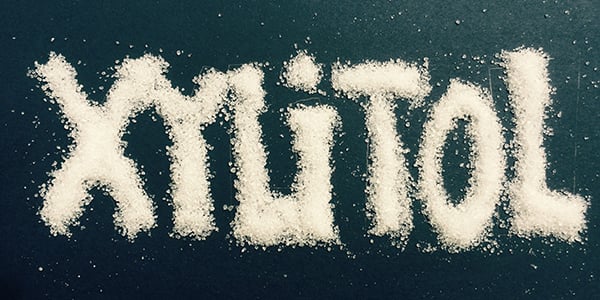
Xylitol Is More Dangerous Than Chocolate
Do you know what xylitol is? Are you (fully) aware of the danger it poses to dogs? You wouldn’t be alone if you answered “no” to either or even both of these questions.
In our ongoing Pet Safety Awareness survey, over 50% of the respondents weren’t aware of xylitol or the danger it poses to dogs until they took the survey!
By comparison, you’d be hard-pressed to find a dog owner who isn’t aware that chocolate can be toxic to dogs. Right?
Yet xylitol can be far more dangerous to dogs than chocolate! The picture below shows the minimum amount of dark chocolate that could cause death in three different weights of dog — compared to the minimum number of pieces of xylitol-containing sugar-free gum that could have the same devastating effect.
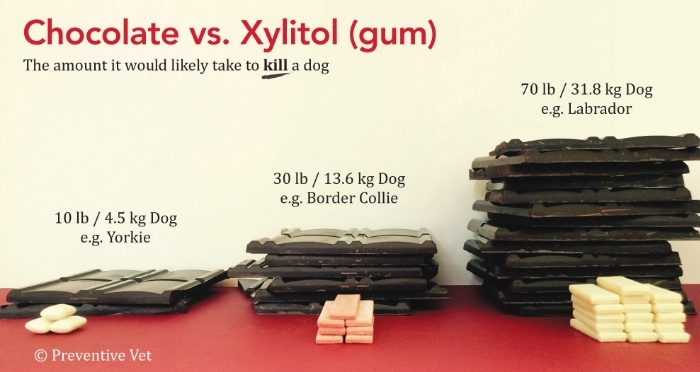
Xylitol-gum quantities are calculated based on a concentration of 1 gram of xylitol per piece of gum and a xylitol dose of 0.5g/kg, resulting in liver failure. (*Note that the amount of xylitol in gum is highly variable and not always noted on the packaging. Read below for information on our efforts to change labeling standards and see what you can do to help.)
The Double Trouble With Xylitol
This general lack of awareness of xylitol and the danger it poses, coupled with the high toxic potency of xylitol in dogs, presents a huge problem! And it’s a problem that’s getting bigger every year, as xylitol is gaining in popularity and being added to more and more common products.
In fact, the odds are good that you have something containing xylitol in your medicine cabinet, your pantry, or even your PURSE right now... without even being aware of it!
This comment was posted on the MNN site when they shared our peanut butter article.
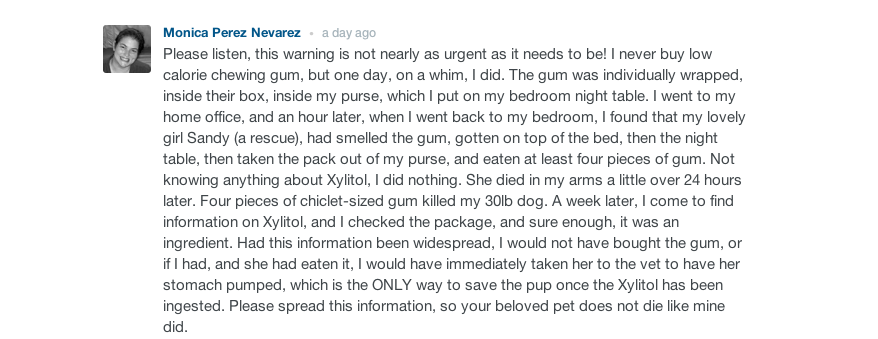
Xylitol: Safe For People, Dangerous for Dogs
Xylitol is a "sugar alcohol," a natural sugar substitute that, because of its anti-cavity properties for human teeth, is commonly found in “sugar-free” gum, mints, toothpaste, and mouthwashes. Since it’s also considered a good sugar substitute for diabetics, xylitol is commonly used in sugar-free baked goods, too, such as cookies and muffins.
Xylitol is also present in some brands of children’s chewable vitamins and other supplements. And it's now even being added to certain brands of PEANUT BUTTER!
Have you ever treated your dogs with peanut butter or used it to help give them some medication? Has your dog ever raided the pantry or gotten into your bag or purse?
It's situations like these that can cause (and routinely have caused) dogs a lot of problems and their families a lot of stress, money, and heartbreak. (Read the #IfOnlyIKnew story of Lucy the Lab and the sugar-free zucchini bread.)
At least if everybody knew about xylitol, and they knew how dangerous xylitol is for their dogs, they could exercise the caution necessary to keep xylitol out of their dog's mouth.
And if their dog got into something containing xylitol, they'd at least be aware of the importance of taking them to the vet immediately. Time is of the essence in treating any toxicity, and that's especially so with xylitol toxicity - as its effects (see below) can be seen in as little as 30 minutes, and they can be absolutely devastating.
Can you see why this awareness is SO IMPORTANT?
Xylitol Poisoning Cases On The Rise As Xylitol Becomes Ever More Common
In a 2004 paper, Veterinary Toxicologist Dr. Erik Dunayer of the ASPCA predicted that “with the increased appearance of xylitol-sweetened products in the US, xylitol toxicosis in dogs may become more common.” And right he was!
According to Dr. Tina Wismer, Veterinary Toxicologist and Medical Director of the ASPCA Animal Poison Control Center (ASPCA-APCC), in 2004, when they first began keeping count of the number of xylitol poisoning calls they were receiving, they logged 201 cases (an average of one case every two days).
Fast forward to 2014, and the xylitol-related calls have reached 3,727. That means that there’s now an average of over TEN calls about dogs being sickened and possibly killed by xylitol EACH day!
Xylitol calls to the ASPCA-APCC in 2018 hit a staggering 6,760 cases, which is a new average of over EIGHTEEN calls per day!!
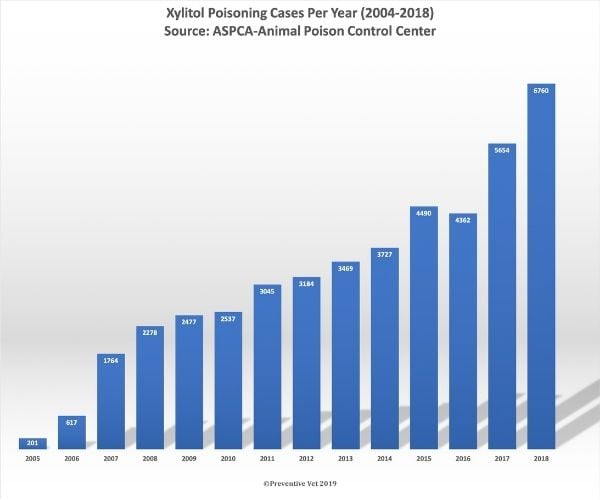
But even these numbers are an underestimate, as they represent only the number of cases that are called into the ASPCA-APCC. This number doesn’t include the calls that Pet Poison Helpline and any other poison control hotlines receive, and they also don’t take into account all of the xylitol toxicity cases that never get phoned into poison control at all.
Many cases are handled at the local animal ER hospital or General Practice clinic without such calls ever being made, and some dogs sadly don’t even make it to the vet.
In fact, xylitol poses a big enough hazard to dogs that, in 2011, the FDA even issued a warning for pet owners about the danger of xylitol ingestion in dogs (See the updated FDA warning May 12, 2016.
And yet another updated-updated FDA xylitol warning came on July 9, 2019.) While these are a nice start, we’d like to see the FDA and manufacturers do more.
Xylitol Is Toxic to Dogs. How Much Is Too Much?
If you suspect your dog has eaten xylitol or something containing xylitol, read this article first! There's a list of what to look out for and what to do. Time is of the essence!!
Because it's such a strong stimulator of insulin release in dogs, it takes just a small amount of xylitol (0.1g/kg) eaten by a dog to cause a dangerous drop in blood sugar ("hypoglycemia").
Mild hypoglycemia will typically cause weakness and a lack of coordination. More pronounced hypoglycemia, such as that which often happens with xylitol ingestion, can lead to seizures, coma, and even death.
Xylitol can cause a dangerous drop in your dog's blood sugar in as little as 30 minutes!
As if that weren't enough, if a dog eats just 0.5g/kg of xylitol (still a very small amount — see the table and picture below), they are at risk of suffering from "acute hepatic necrosis."
Literally translated, "acute hepatic necrosis" means "sudden liver death," and it is a severely debilitating and frequently fatal form of liver failure.
If you're not sure what “0.1g/kg” and “0.5 g/kg” mean, you’re not alone. These are dosages — meaning the weight of something, in this case, xylitol, related to body weight.
The "toxic doses" of xylitol for a 10lb dog, a 30lb dog, and a 70lb dog are shown in the table and the picture below.
While looking at these numbers and piles of xylitol, keep in mind that the typical sugar packet that you might put in your morning coffee weighs 1 gram — more than TWICE the weight of xylitol (0.45 grams) it would take to cause hypoglycemia in a 10lb dog!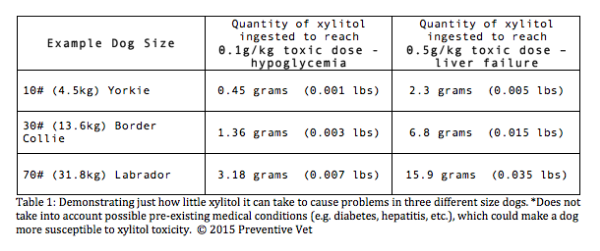
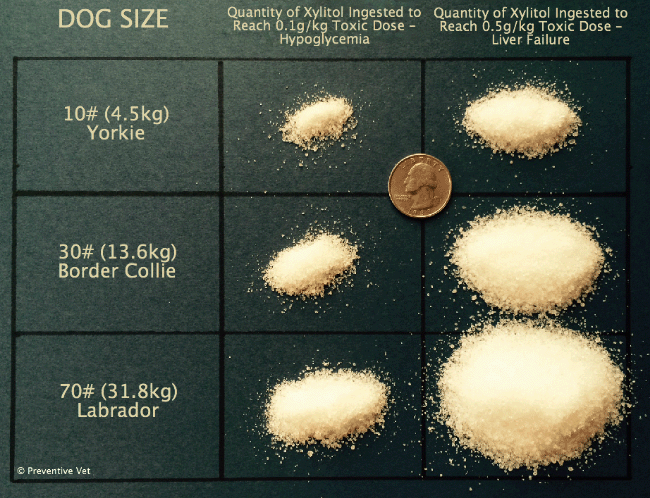
How Much Xylitol Is In Gum (Or Other Products)?
It’s Not Always Possible to Figure It Out.
Here’s the other big part of the problem with xylitol, as it relates to dogs: Though xylitol must be noted in the ingredient list of any product it’s included in, the exact amount or concentration of xylitol in many products doesn’t have to be disclosed and often isn't.
Without this important information, it is extremely difficult to accurately determine a dog's ingested dose in cases of poisoning.
As a result, the "worst-case scenario" often has to be assumed, meaning that dogs may be put through unnecessary testing and hospitalization, and their people may be suffering unnecessary emotional and financial turmoil.
Both situations could often be avoided if xylitol concentrations in products were clearly stated on product packaging and well known within the animal poison control and veterinary medical communities.
Sadly, manufacturers often guard these concentrations as proprietary trade secrets — see the hoops one vet had to go through to get this information from a gum manufacturer just to treat one of her patients. You can help change this, though! Support the Paws Off Act of 2021 (HR 5261) to increase xylitol awareness and information on product packaging.
Until this label awareness becomes common practice (or law), it’s safest to assume that a dog eating any amount of gum, mints, peanut butter, or any other food with xylitol in the ingredient list could be enough to cause serious and potentially fatal problems and therefore warrants an immediate call to an animal-specific poison control hotline or veterinary evaluation.
The same should be assumed with the ingestion of xylitol-containing toothpaste, mouthwashes, and chewable vitamins, too. In fact, with anything containing xylitol.
Immediate recognition of the danger and prompt treatment are of the utmost importance when it comes to xylitol ingestion in dogs. Especially since activated charcoal, a helpful treatment used commonly in many poisoning cases, doesn’t appear to help in cases of xylitol ingestion.
What to Expect If Your Dog Is Sickened By Xylitol
In the event your dog develops hypoglycemia from xylitol ingestion, they will need to be admitted to the hospital for intensive monitoring, and they'll need to be put on an IV dextrose (a source of glucose for your 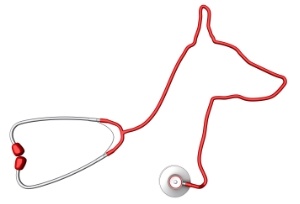 dog's body) drip to support and stabilize their blood sugar levels.
dog's body) drip to support and stabilize their blood sugar levels.
The duration of their hospital stay will vary with the severity of their clinical signs and their response to treatment, but you should expect at least a full day of hospitalization (often 24-48 hours is more likely).
With early and aggressive treatment, the prognosis for xylitol-induced hypoglycemia is typically good, but you should be prepared to pay several hundred to a couple of thousand dollars for treatment costs and the intensive monitoring that is typically necessary.
If your dog is unfortunate enough to develop liver failure from xylitol ingestion, their prognosis will likely not be good. These pets require very aggressive care because of the range of vital functions the liver has (blood clotting, blood detoxification, blood pressure, and many others).
These dogs will often spend at least 72 hours in the hospital, and treatment costs will likely be well into the thousands of dollars. Many of these unfortunate dogs die from their liver failure or are euthanized when the costs skyrocket, and the prognosis worsens.
Make Sure to Read the Ingredient Label
If you're out grocery shopping, sharing a treat with your dog, or you've just noticed that your dog got into something they shouldn't have, from your bag, cupboard, or off the kitchen counter - check the ingredients right away! Xylitol is a natural sugar substitute and is being used more and more for its diabetic and dental benefits in people, but it's toxic and can be fatal to dogs.
Note that there are some common marketing “buzz” terms that you can look for on the front (promotional side) of the product packaging that might indicate that you’ll find xylitol in the ingredient list:
- Sugar-Free
- Reduced Sugar
- All Natural – No Sugar Added
- No Artificial Sweeteners
- Naturally Sweetened
- 100% Natural
- Safe for Sugar-Controlled Diets
- Safe for Diabetics
- Aspartame-Free
- Sweetened with Birch Sugar
- Low Carb
- Low Cal
- Low Calorie
- Helps Fight Cavities
- Cavity Fighting
- Anti-Cavity
- Tooth Friendly
Other names for xylitol in product ingredient lists:
-
Alcohol Sugar (this could include other sugar alcohols and not include xylitol)
-
Birch Sugar
-
Birch Bark Extract
-
CHO
-
E967
-
Kabocha Extract (made from Kabocha pumpkins)
-
Meso-Xylitol
-
Méso-Xylitol
-
Pentahydric alcohol
-
Penta-hydroxy
-
Pentane
-
Sucre de Bouleau
-
Wood Extract
-
Xilitol
-
Xylit
-
Xylite
-
Xylo-pentane-1,2,3,4,5-pentol
Sometimes, xylitol is listed in “inactive ingredients” or in the “other ingredients” list. These lists are not required to be itemized in order of quantity of the ingredient in the product, as it is in the main ingredient label. This, unfortunately, can cause people to incorrectly assume that there is a small amount of it in the product.
How to Protect Your Dog From Xylitol Poisoning
Fortunately, there are several simple preventive measures you can take to help your dogs avoid problems with xylitol:
- Be careful where you put your purse, backpack, briefcase, or any other bag that may contain
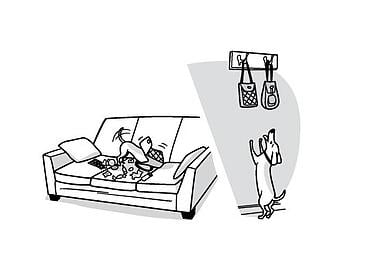 your gum, mints, or even lip balm. Never leave them on the floor, sofa, or chair. Be careful when leaving them on low-lying tables or kitchen counters, too.
your gum, mints, or even lip balm. Never leave them on the floor, sofa, or chair. Be careful when leaving them on low-lying tables or kitchen counters, too.
The safest place to keep such bags is hung on a secure wall hook, on a sturdy coat rack, or hung behind closed closet doors. (This tip can help to prevent a LOT of different types of pet poisonings!) - If you do any sugar-free baking in your household, or if anyone in the home is diabetic, be extremely careful where you store your baked goods and bulk sweeteners. Many dogs will ‘counter surf’ to get to such tasty treats left out on kitchen counters. (And don’t forget about overnight houseguests who may be diabetic.)
- If you brush your dog’s teeth, be sure to use only pet-specific toothpaste. Not only will they not contain xylitol, but they also won’t contain fluoride – which can also be toxic to pets.
- Maintain leash control over your dogs when out on walks. This will help prevent ‘scavenging’ (the act of your dog eating things off the ground). Amongst other things, a scavenging dog could ingest discarded xylitol-containing gum, or somebody’s dropped xylitol-containing muffin.
Consider using a head collar (such as the Gentle Leader® or Halti®) or basket muzzle on dogs that are known to scavenge. - Check the ingredient label of any product you buy. Exercise strict caution around your dogs with any products that have xylitol in their ingredient list. Check out our list of over 700 products that contain xylitol.
- Help convince the manufacturers of xylitol-containing products to begin including xylitol concentrations and awareness warnings on their product packaging. Support the bi-partisan Paws Off Act.
With awareness, understanding, and some simple preventive measures, keeping dogs away from xylitol – and away from the emergency room due to xylitol toxicity – is a mission that we can all achieve.



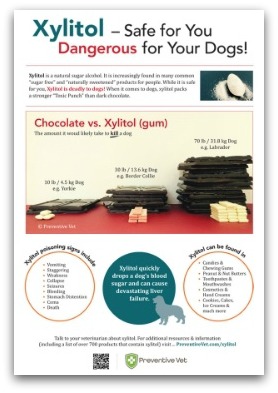

 your gum, mints, or even lip balm. Never leave them on the floor, sofa, or chair. Be careful when leaving them on low-lying tables or kitchen counters, too.
your gum, mints, or even lip balm. Never leave them on the floor, sofa, or chair. Be careful when leaving them on low-lying tables or kitchen counters, too.